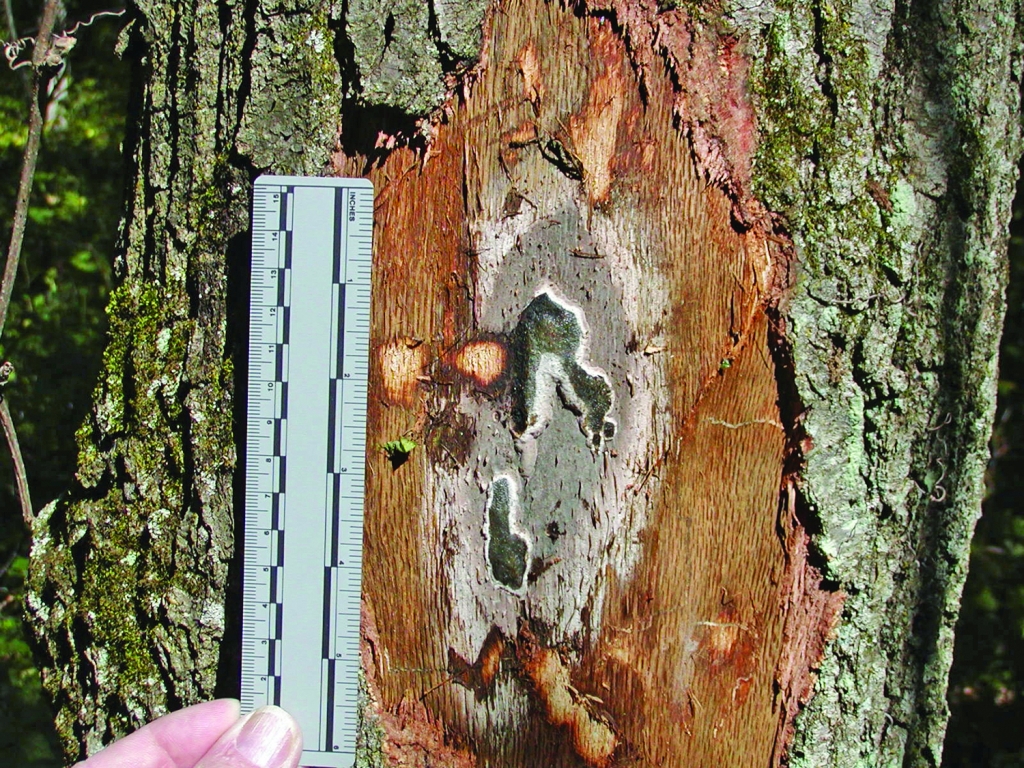
Getting to Know Your Forest Health Team: Mike Hillstrom and Oak Wilt
We are now in the high risk period of the year for oak wilt in Wisconsin...
By Denise Thornton
We are now in the high-risk period of the year for oak wilt in Wisconsin — between April 1 to July 15— and fortunately, the WDNR has been working on new treatments as well as a new tool land owners can use to control it.

“Over half the calls I get are about oak wilt,” says Mike Hillstrom, WDNR forest health specialist. This is particularly an issue for species in the red oak group such as northern red, northern pin, and black oaks — identifiable by their pointy-lobed leaves.
Trees that died from oak wilt last year have produced a spore mat (mat of fungus beneath the bark). “The fungal mats can crack the bark open, but it may be 30 feet up in the tree where a landowner can’t see it,” Hillstrom says. “We have photos on our website.”
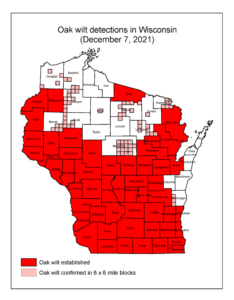
Sap beetles are drawn to feed on these mats, and they transfer fungal spores to healthy trees that have exposed sap. A little bit of damage from construction or a storm, or any tree that is cut or pruned during the high-risk period can be infected. “It doesn’t take a lot,” Hillstrom says. “The beetles sense their food source and can find trees within 15 minutes of a wound occurring if they are in the area.”
The fungus then moves into the healthy tree’s water transport system, and quickly clogs it, at which point that tree will die. “We see wilting from late June to early October,” says Hillstrom. Once oak wilt has been transferred by beetles to a tree, a second wave spreads below ground through connecting roots to nearby trees. This is the point where a landowner can make a difference.
“When a forest owner calls me up, I’ll go out to take branch samples from a declining branch, or depending on the situation, we may do a wood window and take a chunk of wood from the side of the tree. It goes to our forest lab in Fitchburg where we can diagnose oak wilt,” he says. “If it is oak wilt, the next step is helping owners with their management options.”
Standard Treatment
The tried and true method is root disruption — literally severing the roots between infected and healthy trees. “If one tree is dead, we assume the next tree out is probably already infected, so you need to set a root rupture barrier between these healthy-looking trees that are probably infected and the slightly more distant, uninfected trees using a tool that can dig five to six feet into the ground,” Hillstrom says.
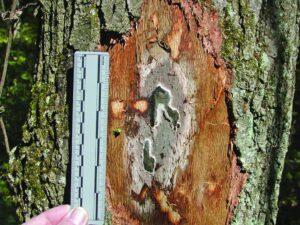
Root graft distance is about tree height. “If you dropped that tree in any direction, any tree that it would touch has to be included inside the trench.”
This trenching is usually done with a backhoe or a vibratory plow (usually used to cut a slit in the ground to lay a small-diameter utility cable or pipe). Because many landowners do not have access to a backhoe or vibratory plow, the DNR has been researching a new method of control.
New Girdle-Herbicide Treatment
“We did a study of the girdle-herbicide method,” says Hillstrom. “You set a perimeter between the infected trees and surrounding healthy trees. Then you girdle trees within the perimeter as low on the base as you can and make another girdle 10 inches higher. Treat the debarked space between the girdles with triclopyr. The idea is the herbicide goes into the roots, causing them to die before the fungus can transfer to the next trees. This method has been used for more than 10 years around the state. Using a chain saw and herbicide is much more accessible for most land owners, so it’s more likely land owners will take action.”
It is an effective method, especially for smaller pockets of three to 10 trees. “It’s not great to sacrifice healthy-looking trees, but since they’re probably already infected, the fungus is going to spread and kill them anyway,” says Hillstrom. “It can be worth the costs in most cases. If a tree seems marginal — include it. If oak wilt breaks out it will get that tree and spread even farther.”
“Triclopyr, available from most ag retailers is not something to handle carelessly,” Hillstrom emphasized. “Make sure to read the label, use the recommended amount, and wear appropriate safety gear, including eye protection.” He also recommends mixing it with bark oil rather than the sometimes used diesel fuel. “Bark oil helps it soak into the tree and is more environmentally friendly.”
“People ask me, ‘Can I cut the tree and treat the stump rather than doing the whole girdle thing?’” says Hillstrom, but he warned, “The evidence for whether this works is mixed. This needs more research. If that is your only option, it’s better than doing nothing.” He emphasized, “Just cutting the tree without treating it will definitely not stop the root spread.”
Rapid Response Method Still Being Tested
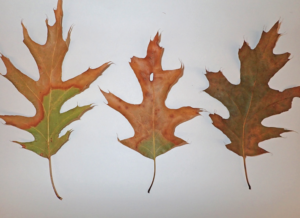
Another new method that the WDNR is starting to test is called Rapid Response. “This is for trees that are newly infected. It takes a while after the beetle brings in fungal spores for the fungus to grow through the water transport tissue and infect the roots. So you have a little time to stop the fungus from spreading.”
“If you girdle the tree with a chain saw and spray it with herbicide, that may stop the infection from ever getting to the roots. We are testing it now,” Hillstrom says. “Hopefully it works, and in the future we can recommend it as an effective method.”
The best time to watch for oak wilt is from late June through October, depending on where you are in the state and the weather conditions. You are looking for a tree that starts wilting from the top down. Bronzy, water-soaked leaves work their way down the tree rapidly as the fungus clogs its water system. As the leaves drop to the ground, they may still have green on them.
“Rapid wilting and mortality are the key things to watch for,” says Hillstrom. “I get a lot of calls where people tell me the tree has been declining over the last couple of years. This is usually not oak wilt. It may be an insect issue or a different fungus, and there may be a weather or soil component. Not everything is oak wilt, especially if it moves slowly.”
New Tool for When It Is Safe to Cut Oak
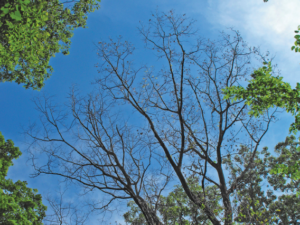
The common wisdom is to not cut oaks in the southern part of the state from April 1 to July 15 and in the northern part of the state from April 16 to July 15. “This is when the spore mats of the fungus and the beetles are out, which can vary depending on conditions each spring,” Hillstrom says.
“Last year we worked with the UW-Madison to create a tool now on our DNR oak wilt webpage. This gives you a more specific date. The beetles are still flying around, but the fungal mats are less dangerous. The risk is not zero, but it is so much reduced that, from a forestry perspective, we can’t justify cutting restrictions.”
“We are here as a resource for land owners to ask us questions,” says Hillstrom. A lot of people are aware of oak wilt but don’t know these new details.” If woods owners can find pockets and quickly girdle and herbicide, hopefully they can stop oak wilt loss at just a few infected trees.
